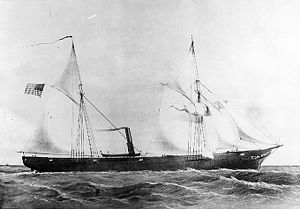USS Kanawha (1861)
 Lithograph by Shearman & Hart, New York, circa 1861, entitled "U.S. Steam Gun Boat Kanawha. Built by C.E. & W.H. Goodspeed. East Haddam, Connecticut". | |
| Career (USA) | Union Navy Jack 100x35px |
|---|---|
| Namesake: | A river in southwest West Virginia formed by the confluence of the New and Gauley Rivers at Gauley Bridge, West Virginia. |
| Builder: | G. B. & W. H. Goodspeed, East Hadden, Connecticut |
| Laid down: | date unknown |
| Launched: | 21 October 1861 |
| Commissioned: | 21 January 1862 at the New York Navy Yard |
| Decommissioned: | 5 July 1865 |
| Struck: | 1866 (est.) |
| Fate: | sold at New York City 13 June 1866 |
| General characteristics | |
| Displacement: | 507 tons |
| Length: | 158 ft (48 m) |
| Beam: | 28 ft (8.5 m) |
| Draught: | 7 ft 8 in (2.34 m) |
| Propulsion: | steam engine, screw-propelled |
| Speed: | not known |
| Complement: | 87 |
| Armament: | six 24-pounder howitzers |
USS Kanawha (1861) was a steamer acquired by the Union Navy during the American Civil War. She was used by the Navy to patrol navigable waterways of the Confederacy to prevent the South from trading with other countries.
Contents
Commissioned at New York City
Kanawha was launched 21 October 1861 by G. B. & W. H. Goodspeed, East Hadden, Connecticut; and commissioned at New York Navy Yard 21 January 1862, Lt. John C. Febiger in command.
Civil War service
Assigned to the Gulf Blockade
Assigned to the Gulf Blockading Squadron, the new gunboat arrived off Pass a l'Outre, Louisiana, 13 February and a week later was ordered to take station off Mobile, Alabama, where she soon distinguished herself for vigilance.
Kanawha proves very efficient at capturing blockade runners
She drew first blood with a vengeance 10 April capturing four blockade-running schooners in a single day: Southern Independence, Victoria, Charlotte, and Cuba. The first three had attempted to slip to sea laden with cotton and naval stores while the latter had tried to run into Mobile, Alabama, with supplies badly needed by the South.
Thereafter, her kills were frequent. She caught schooner R. C. Files carrying cotton out of Mobile 21 April and took British sloop Annie on the 29th between Ship Island and Mobile headed for Cuba. On 17 November near Mobile she and Kennebec chased an unidentified schooner ashore where she was set afire by her crew. Then the guns of the Union ships assured her complete destruction by preventing Confederate coast guards from boarding her to extinguish the flames.
On 25 March 1863 Kanawha, then commanded by Lt. Comdr. William K. Mayo, took schooner Clara attempting to run the blockade at Mobile. Schooner Dart attempted to slip into Mobile from Havana, Cuba, 1 May but fell prey to this vigilant blockader. A fortnight later the same fate befell British brig Comet some 20 miles east of Fort Morgan on Mobile Point. On 17 May Kanawha snared schooner Hunter, laden with cotton for Havana, running out of Mobile. The next day she caught schooner Ripple attempting the same feat.
Kanawha is hulled by a cannonball from Fort Morgan, and smartly backs off
Dawn of 12 October disclosed steamer Alice aground under the guns of Fort Morgan and an unidentified Confederate tug attempting to pull her free. Kanawha, accompanied by tender Eugenie, steamed boldly toward the strongly defended Confederate shore to destroy the Southern vessels; but Fort Morgan's batteries, outranging the guns of the Union ships, hulled Kanawha, forcing the Union ships to retire. Lackawanna and Genesee then headed in to finish the task with their 150-pounders; but, before they got in range, the daring tug managed to refloat Alice and escaped with her into Mobile Bay.
Undermining the South’s financial structure
On 29 November Kanawha took schooner Albert, also called Wenona, attempting to carry cotton, naval stores, and tobacco out of Mobile. The toll collected by relentless Northern blockaders like Kanawha in capturing Southern blockade runners steadily drained away the life blood of the Confederacy. The loss of ships carrying the products of Southern fields and forests to foreign markets undermined the South's financial structure and increased her difficulty in purchasing war material abroad. The loss of incoming ships deprived Southern armies of a growing proportion of the shrinking supplies and equipment persuasive Confederate agents did manage to procure.
Reassigned to patrolling the Texas coast
In the spring of 1864 Kanawha was transferred to the Texas coast. On 8 July, now under Lt. Comdr. Bushrod B. Taylor, she forced steamer Matagorda aground near Galveston, Texas. On 9 September, after Union troops had been withdrawn from the area, Kanawha reinstituted the blockade of Brownsville, Texas, which had been lifted by Presidential proclamation in mid-February. On 28 December she forced an unidentified sloop ashore near Caney Creek, Texas, and destroyed her. She captured Mary Ellen of Montreal, Canada, 3 January 1865 as the schooner tried to run into Velasco, Texas. She remained on blockade duty until after the end of the war and was ordered north 27 May.
Post-war decommissioning and sale
Kanawha decommissioned 5 July and was sold at New York 13 June 1866.
References
This article includes text from the public domain Dictionary of American Naval Fighting Ships. The entry can be found here.
See also
External links
- Pages with broken file links
- Wikipedia articles incorporating text from the Dictionary of American Naval Fighting Ships
- Ships of the Union Navy
- Ships built in Connecticut
- United States Navy steamships
- Gunboats of the United States Navy
- Tugs of the United States Navy
- American Civil War patrol vessels of the United States
- United States Navy West Virginia-related ships
- 1861 ships
